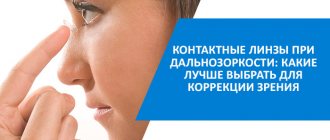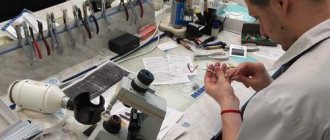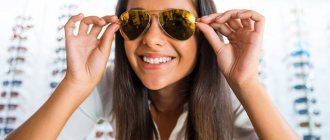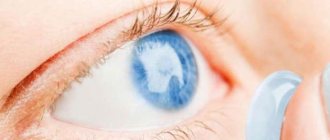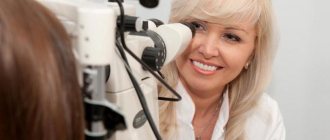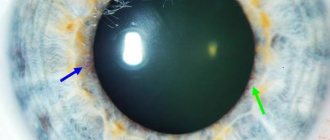What is the radius of curvature of a contact lens?
Radius of curvature (base curve, denoted BC) - indicates the level of curvature of the inner surface of the contact lens.
Basic curvature is the main geometric parameter that is responsible for comfortable wearing of vision correction equipment.
It depends on the structure and shape of the eyeball. This value cannot be the same for everyone, it differs for each patient using soft contact lenses. It should resemble the curvature of the patient’s cornea as closely as possible and follow its contours.
The BC or BS values are indicated on the product packaging.
Some products have a gradually increasing radius of curvature, from the central object to peripheral vision. Such lenses are prescribed to individuals diagnosed with astigmatism. The packaging indicates 2 values at once - minimum and maximum. As the base curve of the inner surface of the lens increases, its sagittal size decreases, and vice versa.
DETERMINATION OF THE RADIUS OF CURVATURE OF THE LENS SURFACE.
⇐ PreviousPage 3 of 7Next ⇒GOAL OF THE WORK
Study of the geometric characteristics of the lens and familiarization with one of the methods for determining the radius of curvature of the lens.
THEORETICAL BASIS OF WORK
A lens is a transparent body bounded by spherical surfaces (one of the surfaces may be flat).
Lenses are biconvex, biconcave, plano-convex, plano-concave, convex-concave, concave-convex.
Convex-concave and concave-convex lenses are called meniscus lenses. They are used, in particular, with glasses.
Lenses are made from various materials - glass and plastic for visible radiation, quartz for ultraviolet, rock salt (or sylvinia) for infrared.
The lens formula relates the focal length F to the distance from the optical center of the lens to the object d and to the image f:
. (1)
The focal length F is substituted into this formula with a “+” sign if the lens is converging, and with a “-” sign if the lens is diverging.
The distance to the image f is substituted with a “+” sign if the image is real, and with a “-” sign if it is imaginary.
The value is called optical power and is measured in diopters (Dopters).
= diopter
The optical power of a lens is related to its geometric characteristics by the formula:
, (2)
where nl
and
no
are the refractive indices of the lens and the environment;
R1
and
R2
are the radii of curvature of the lens surfaces, which are substituted with a “+” sign in the case of a convex surface and with a “-” sign in the case of a concave surface.
If formula (2) yields Ф
> 0, then the lens is converging,
Ф
< 0 - diverging.
This is due to the signs of both parentheses on the right side. For example, when R1
> 0,
R2
> 0 (biconvex lens), we obtain a converging lens if
nl
>
no
(for example, a glass lens in air) and a diverging lens if
nl
<
no
(for example, an air lens in glass).
In another case, there may be nl
<
no
(air lens in glass), but
R1
< 0,
R2
< 0, that is, the surfaces of the lens are concave. Then each bracket will have a “-” sign, and their product will give “+”, and the lens will be converging.
Transverse lens magnification, (3)
where y1
and
y2
are the distances, respectively, of the luminous point and its image to the main optical axis of the lens.
The converging lens can be used as a magnifying glass. In this case, its increase is equal to
where D
- this is the distance of best vision;
for a normal eye, D
= 25 cm - one of the standards for creating optical instruments that arm the eye;
F
is the focal length of the magnifying glass.
The most important optical instruments made from lenses include the microscope and telescope.
Microscope Magnification
, (4)
where D
— the distance between the focal points of the lens and the eyepiece, called the length of the microscope tube;
D
is the distance of best vision;
Fob
and
Fok
are the focal lengths of the lens and eyepiece, and in a microscope
Fob < Fok
.
Telescope magnification, (5)
where Fob
and
Fok
are the focal lengths of the lens and eyepiece, and in the telescope
Fob > Fok
.
DESCRIPTION OF THE EXPERIMENTAL INSTALLATION
In this work, on a setup with lens 3 (Fig. 1)
| Fig.1 Micrometer. |
The radius of curvature R
of the lens can be measured using indicator 2 (Fig. 1). If we imagine the cross section of the lens as a segment of a circle (Fig. 2), then according to the Pythagorean theorem we obtain:
,
where a
— chord,
h
— segment arrow.
After transformations we get the radius value:
. (6)
Moving the lens horizontally, measure the length of the chord a
, recording the corresponding arrow of segment
h
according to the micrometer readings.
Using formula (6), you can calculate the radius of
curvature R.
The installation diagram is shown in Fig. 1. By moving the stand with micrometer 2 by hand, you can record readings on scale 4 (half a chord a
/2) and the corresponding micrometer readings - the arrow of segment
h
. The whole number of millimeters on a micrometer is shown by a small arrow, and tenths and hundredths are shown by a large arrow.
PROCEDURE FOR PERFORMANCE OF THE WORK
WARNING. Make sure that the optical surfaces of the lens remain clean - do not touch them with your fingers or objects. The indicator is a precise instrument and all manipulations with it must be performed smoothly, without jerking. If the micrometer readings differ from zero, the micrometer can be adjusted with a wheel located on top of the axis.
1. Zero setting. Use the wheel to achieve zero readings on the small and large arrows. In this case, the large arrow should be close to the vertical position. With the micrometer in this position, you need to find the highest point of the lens. To do this, place the lens on the lower cone and smoothly release the spring of the pressure cone until you find the top of the spherical surface of the lens. In this case, it is necessary to take into account that near the top there is a dead zone with a length of about 2 mm, within which the needle does not move - the stand must be installed in the middle of this zone. Next, by rotating the micrometer wheel, align the zero of the dial scale with the position of the large arrow. Considering that the accuracy of setting the zero determines the accuracy of further measurements, repeat the manipulations of step 1 one or two more times so that the zero of scale 4 coincides with the zero of the micrometer and this corresponds to the top of the spherical surface of the lens.
| Indications on graph paper | Micrometer reading | Boom segment(mm) | Radius of curvature of lens R (mm) |
| When moving to the right h1 (mm) | When moving left h2 (mm) | ||
| … | |||
| = |
Table 1.
2. Moving the lens from the center to the left edge along the graph paper attached to the flat side of the lens, write down the readings h1
(segment arrow) to Table 1. In this case, take the whole number of millimeters according to the indications of the small arrow, and tenths and hundredths - according to the indications of the large arrow.
3. Move the lens from the center to the right edge, take a reading on the h2
at the same values of half the chord.
4. Subtract the value of h
at the edge of the lens from the
h
at the center to get
the h
segment of the sphere.
4. Find the arithmetic mean < f
> observation results and determine the half-width of the confidence interval
Df
.
Write down the measurement result f
as:
± Df.
5. Fill out table 1 and use formula 6 to determine the radius R
curvature of the lens in millimeters.
Find the arithmetic mean <R> and
the half-width of the confidence interval
DR
.
CONTROL QUESTIONS
1. State the purpose of the laboratory work.
2. What is a lens?
3. What materials are lenses for ultraviolet and infrared radiation made from?
4. Specify the formula of the lens.
5. What value is called the optical power of a lens?
6. In what units is the optical power of a lens measured?
7. Specify the sign of the focal length F
lenses for converging and diverging lenses.
8. Indicate the distance sign f
real and imaginary images to the lens.
9. How does the optical power of a lens depend on the radii of the surfaces delimiting the lens?
10. Parallel rays of light fall on a glass biconcave lens in air. How are these rays directed after passing through the lens?
11. Parallel rays of light fall on an air biconvex lens in glass. How are these rays directed after passing through the lens?
12. What value is called the transverse magnification of the lens?
13. Write the formula for magnifying a magnifying glass.
14. The spectacle lens is made of crown glass with refractive index n
= 1.5. The radius of curvature of the convex and concave surfaces of the lens are 50 cm and 25 cm, respectively. Determine the optical power of the lens.
15. Solve the previous problem for a plane-convex lens if the radius of curvature of the convex surface is R
= 50 cm.
16. Indicate what images will be obtained in a collecting lens at d
= 2
F
,
d
= 3
F
,
F
<
d
<
2 F.
17. Construct magnified and reduced images given by a converging lens.
18. Construct a virtual image given by a converging lens.
19. Construct the image given by a diverging lens.
20. Draw a sketch of the experimental setup.
21. Provide the calculation formula for determining the focal length F
lenses.
22. What formula should be used to calculate the half-width DF
confidence interval of the focal length
F
of the lens?
23. Derive a formula for determining the refractive index n of a plano-convex lens in this work.
24. What formula should be used to calculate the half-width Dn
confidence interval of the refractive index n of the lens in this work?
25. Derive a formula for calculating the radius of curvature R
plano-convex lens in this work.
26. Determine the refractive index of a plano-convex lens whose focal length is twice the radius of curvature of the convex surface.
27. Find the focal length of the lens F
, if the actual image of the object is located from the lens at a distance twice the distance of the object to the lens, and the distance between the object and its image is 30 cm.
28. How will the focal length of a collecting glass lens change ( nL
= 1.5), if it is placed from air (
n01
» 1) into water (
n02
= 1.33)?
29. Does the distance d of the object to the lens change in this work?
30. Indicate the procedure for performing this laboratory work.
⇐ Previous3Next ⇒
Didn't find what you were looking for? Use Google search on the site:
Lens curvature in numbers
There is a standard BC value, most often found in adults - 8.6 mm. It can fluctuate between 8.3–9.0 mm. For example, with myopia, the transparent membrane in the front of the eye becomes more convex, and with keratoconus, it rises above the eyeball.
It is not difficult to select a CL in accordance with BC if BS does not go beyond the established boundaries. For other BS, lenses are ordered individually. They take longer to make, but perfectly describe the shape of the cornea.
Basic indicators of lens curvature
The ophthalmologist's prescription (if the product was prescribed by him) must indicate both the diameter and the base curvature. Compliance with this parameter will allow you to place the lens on the cornea with maximum comfort, and vision correction will be more effective.
For maximum wearing comfort, the radius of curvature must match the parameters of the patient’s cornea. Then the fit will not be difficult, the product will fit well to the eyeball, not fall off or put pressure on it.
The base curvature is indicated on the contact lens packaging along with the optical power. It is measured in millimeters. The higher its number, the flatter the lens. Accordingly, the lower the number, the more curved the product.
Types of curvature
The curvature parameters are indicated by the Latin letters BC and are located on the back of the package. The standard radius varies from 8.3 to 9 mm. For different people, these figures can range from 7.5 to 9.5 mm. This depends on the size and shape of the eye.
Within the boundaries of standard curvature, choosing the right model will not be difficult. If individual indicators turn out to be higher or lower than these limits, then the product will have to be made to order. This is due to the fact that more than 85% of contact lenses sold in the pharmacy chain have a standard curvature of 8.3 to 8.8 mm. However, if the deviation from the standard is no more than 0.2 mm, their use is permitted. For the most part, wearing models with minimal differences does not cause any discomfort.
For people suffering from astigmatism, special toric lenses are used. They have two convexities located at different angles and have two curvature indicators.
Determining the appropriate radius
The base curve is determined by an ophthalmologist or ophthalmologist using refractokeratometry. It is impossible to do this on your own. It is also undesirable to follow the advice of the seller, who recommends choosing a CL by fitting. Thus, it will not be possible to determine the exact curvature of the cornea.
A refractometer is an ophthalmic diagnostic instrument that measures the radius of curvature of the cornea. Invisible infrared rays are projected onto the bottom of the patient's eyeball. The image is subjected to electron-optical analysis to determine the process of refraction of light rays in the optical system of the eye.
Thanks to refractokeratometry, the doctor quickly detects anomalies and diagnoses the presence of myopia, astigmatism, and hypermetropia in the early stages.
For an objective study of the clinical refraction of the eye, an autorefkeratometer is used. It allows you to determine the size and radius of curvature of the cornea, pupil width and interpupillary distance.
This device is an integral part of optics. The device makes it easier for doctors to work by allowing them to focus on the patient without having to deal with intermediate measurements and analysis.
The measurement is carried out using infrared radiation. Sensors record the image of this beam, and with the help of software, the device produces a refraction value.
After completing the diagnostic procedure, the ophthalmologist gives the patient a prescription for lenses, indicating:
- optical power (measured in diopters);
- diameter and base convexity;
- distance between pupils and other parameters.
If you need to change lenses from one manufacturer to another, you should undergo a re-examination. CLs presented on the ophthalmological market differ in characteristics and features.
How to determine the radius of curvature of a lens
There is no universal option that suits everyone without exception. But the majority of products have eye lens diameters from 8.2 to 8.8 millimeters. Less common are models with characteristics of 7.9–8.2 and 8.8–9.0. If the cornea has individual structural features, then accordingly the optics should be selected taking into account these nuances.
How to determine the size of eye lenses? To measure the curvature, you will need to visit an ophthalmologist. Using an autorefractometer device, he will carry out the procedure. The device emits an infrared beam; it will take a maximum of ten minutes to measure the desired parameter. During the examination, the patient does not experience pain or discomfort.
The light flux is reflected from the mesh shell and the information is recorded by special sensors. Based on the information obtained, the optimal parameters for corrective optics are selected. The patient is then fitted with a trial lens and the doctor performs a slit lamp examination of the fundus.
To make sure that the eyepiece is not too tight, fluorescein is instilled into the organ of vision. This is a unique solution that glows under the rays of an ultraviolet lamp. Based on the intensity of coloring and the depth of penetration of the pigment, it will not be difficult for the doctor to determine whether the radius of curvature is chosen correctly.
The result of a visit to the ophthalmologist is a prescription, which reflects the basic characteristics of corrective optics.
How to understand that the lenses are chosen correctly
To find out whether the doctor prescribed the correct lenses or not, a test is performed for excessive or insufficient lens mobility. The CL is slightly shifted upward and the reverse movement is observed. The product must return to its previous position; if it moves downward, products with a different radius curvature are selected.
CLs are selected correctly if:
- visual perception has improved;
- does not move;
- does not feel like a foreign body;
- does not swim;
- does not cause burning, lacrimation or other unpleasant symptoms.
The second way to check is to perform a fluorescein test. If BC is not detected correctly, fluorescein collects at the edges or in the center.
The third is the use of special complex instruments to determine the correct position of the optics.
How to choose contact lenses?
Before purchasing lenses at an optical salon, you should definitely visit an ophthalmologist or contact correction specialist. Typically, the choice of colored lenses is based on available data on product parameters and personal color preferences.
You can read reviews from those who have already tried certain lenses: this information will certainly be useful. The price of contact lenses depends on the length of time they are worn, the material and the manufacturer, and is often very affordable.
Why is optimal curvature so important?
Lenses have many advantages, they not only improve visual perception.
They do not put pressure on the bridge of the nose like glasses and do not cause discomfort if properly cared for and used. They are used at any time of the year. It is important to select a contact vision correction product from a doctor, since it is based on optimal strength, BC and other parameters.
BC is important because inadequacy of this parameter leads to damage to the outer membrane of the eye.
A deviation of even 0.2–0.3 mm BC is unacceptable. Doctor mistakes can cause irreparable harm to eye health. The importance of correct selection of BS can be realized by assessing the consequences of incorrectly selecting CL.
If the doctor makes a mistake in the optical strength, CLs may turn out to be weak or too strong for the patient. This leads to visual fatigue called asthenopia. It manifests itself as headache, eye strain, pain in the bridge of the nose.
If the radius of curvature is incorrectly set, contact lenses do not fit correctly on the eye. Air accumulates between the contact lens and the eye, which leads to the product falling out or moving. When the CL is displaced, the cornea is injured.
Optical products feel like a foreign body in the eye and create discomfort when worn. Such signs are of concern when prescribing CL with a large BC.
If prescribed with a smaller radius of curvature, the SCL will compress the cornea. They interfere with the free circulation of tear fluid, leading to insufficient hydration and hypoxia of the cornea (oxygen starvation).
Wearing contact lenses with small BC causes damage to the corneal epithelium.
Such contact vision correction products cannot be worn; they lead to damage to the cornea. An inflammatory process may develop, manifested by clouding and ulceration of the cornea.
The most serious complication is deterioration in vision, which is a consequence of the appearance of a whitish vascularized spot on the eye. Incorrect selection of BS causes swelling of the cornea.
If problems arise with the CL, you should remove them in accordance with the instructions and seek medical help. They will conduct a re-examination and prescribe lenses with the correct radius of curvature.+
Radius of curvature of the trajectory
This article presents two problems that will help you learn to determine the radius of curvature of a trajectory when a body moves at an angle to the horizontal. Each of the tasks represents a whole set, so there should be no ambiguities left. Problem 1. A body is thrown at a speed of 10 m/s at an angle to the horizontal. Find the radii of curvature of the body's trajectory at the initial moment of its movement, after a time of 0.5 s and at the point of the highest rise of the body above the earth's surface. As is known, the radius of curvature of a trajectory is related to normal acceleration and speed by the formula:
Where :
That is, to find the radius of curvature of the trajectory at any point, you only need to know the speed and normal acceleration, that is, the acceleration perpendicular to the velocity vector. Let's consider all given points and determine the velocities and the necessary acceleration components at them.
To task 1
The simplest thing is to determine these values at the point of highest rise. Indeed, the vertical component of the velocity here is equal to zero, therefore the velocity of the body at a given point is equal to the horizontal component, and the acceleration normal to the vector of this velocity is the acceleration of gravity, therefore
The second easiest to calculate is the starting point of movement. We already know the speed in it, we just need to figure out the acceleration. Let us decompose the acceleration of free fall into two components: and . The first is perpendicular to the speed, which is what we need. Determine the radius:
Finally, the point where the body will be in half a second. Our body will fly horizontally at a constant speed equal to . Vertically, the body will move uniformly slow until the middle of the trajectory (highest point), and then uniformly accelerated. Let's determine whether the body will have time to reach the apogee:
A simple rough calculation shows that the point we need is in the first half of the trajectory, where the body is still moving upward. Then its speed along the axis:
Let us determine the total speed of the body at the moment of time:
The angle of inclination of the velocity vector to the horizon at this moment is equal to:
And you could immediately find the cosine:
Then the required radius of curvature of the trajectory is equal to:
Answer: m, m, m.
Problem 2. At what angle to the horizon should the ball be thrown so that a) the radius of curvature of the trajectory at the initial moment of time is 8 times greater than at the vertex; b) the center of curvature of the top of the trajectory would be on the surface of the earth? Let's write the condition of the problem as follows: a) , b). a) As in the previous problem, we determine the radius of curvature of the trajectory at the throwing point. We know the speed, and the normal acceleration will be the projection of the acceleration of gravity:
Let us now determine the radius of curvature at the vertex:
By condition :
b) We have already determined , the maximum lift height remains.
We determine time from the condition that the vertical component of velocity is equal to zero in the same way as we did in the previous problem:
We equate and:
Where .
Answer: a) , b) .


